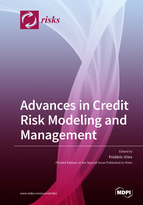Advances in Credit Risk Modeling and Management
A special issue of Risks (ISSN 2227-9091).
Deadline for manuscript submissions: closed (31 March 2019) | Viewed by 38796
Special Issue Editor
Special Issue Information
Dear Colleagues,
Correctly assessing credit risk still represents an important challenge for both practitioners and scholars. On the one hand, credit risk measures play a central role in the banking sector’s regulations, governing the profitability of financial institutions which remain at the heart of our economic system. On the other hand, effectively computing such measures in a sound and rigorous way triggers important challenges because of the lack of relevant information and/or models. In practice, computing a 99.9% VaR in a statistically meaningful way is not so easy, and typically requires a lot of assumptions that may significantly impact the figures. It is therefore important that academics pursue efforts to improve this.
This Special Issue aims at collating papers contributing methodologically and/or computationally, towards a more rigorous and reliable management of credit risk of financial institutions. Theoretical and empirical research works covering theoretical properties and/or computational aspects of risk measures are welcome.
Prof. Dr. Frédéric Vrins
Guest Editor
Manuscript Submission Information
Manuscripts should be submitted online at www.mdpi.com by registering and logging in to this website. Once you are registered, click here to go to the submission form. Manuscripts can be submitted until the deadline. All submissions that pass pre-check are peer-reviewed. Accepted papers will be published continuously in the journal (as soon as accepted) and will be listed together on the special issue website. Research articles, review articles as well as short communications are invited. For planned papers, a title and short abstract (about 100 words) can be sent to the Editorial Office for announcement on this website.
Submitted manuscripts should not have been published previously, nor be under consideration for publication elsewhere (except conference proceedings papers). All manuscripts are thoroughly refereed through a single-blind peer-review process. A guide for authors and other relevant information for submission of manuscripts is available on the Instructions for Authors page. Risks is an international peer-reviewed open access monthly journal published by MDPI.
Please visit the Instructions for Authors page before submitting a manuscript. The Article Processing Charge (APC) for publication in this open access journal is 1800 CHF (Swiss Francs). Submitted papers should be well formatted and use good English. Authors may use MDPI's English editing service prior to publication or during author revisions.
Keywords
- recovery rate modeling
- default models
- computational techniques
- economic capital
- Basel regulation
- counterparty risk
- risk measures






